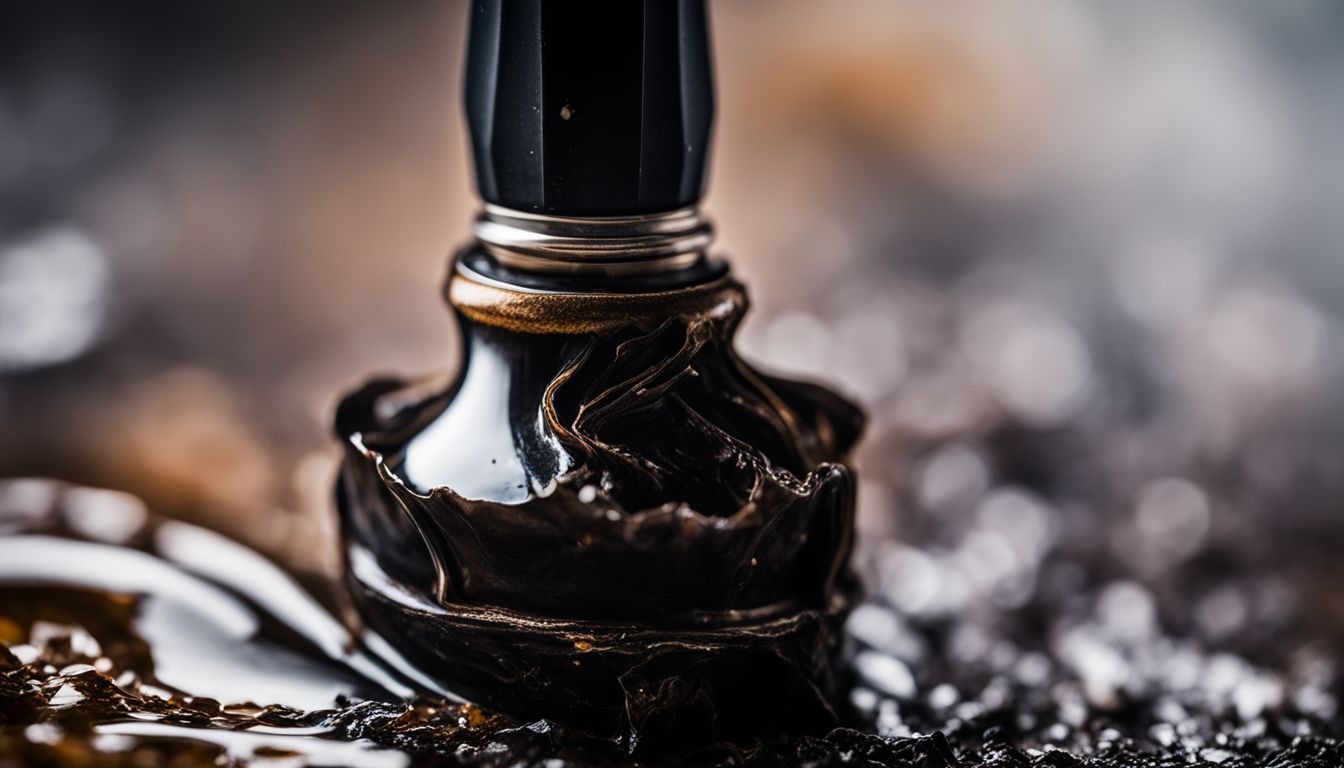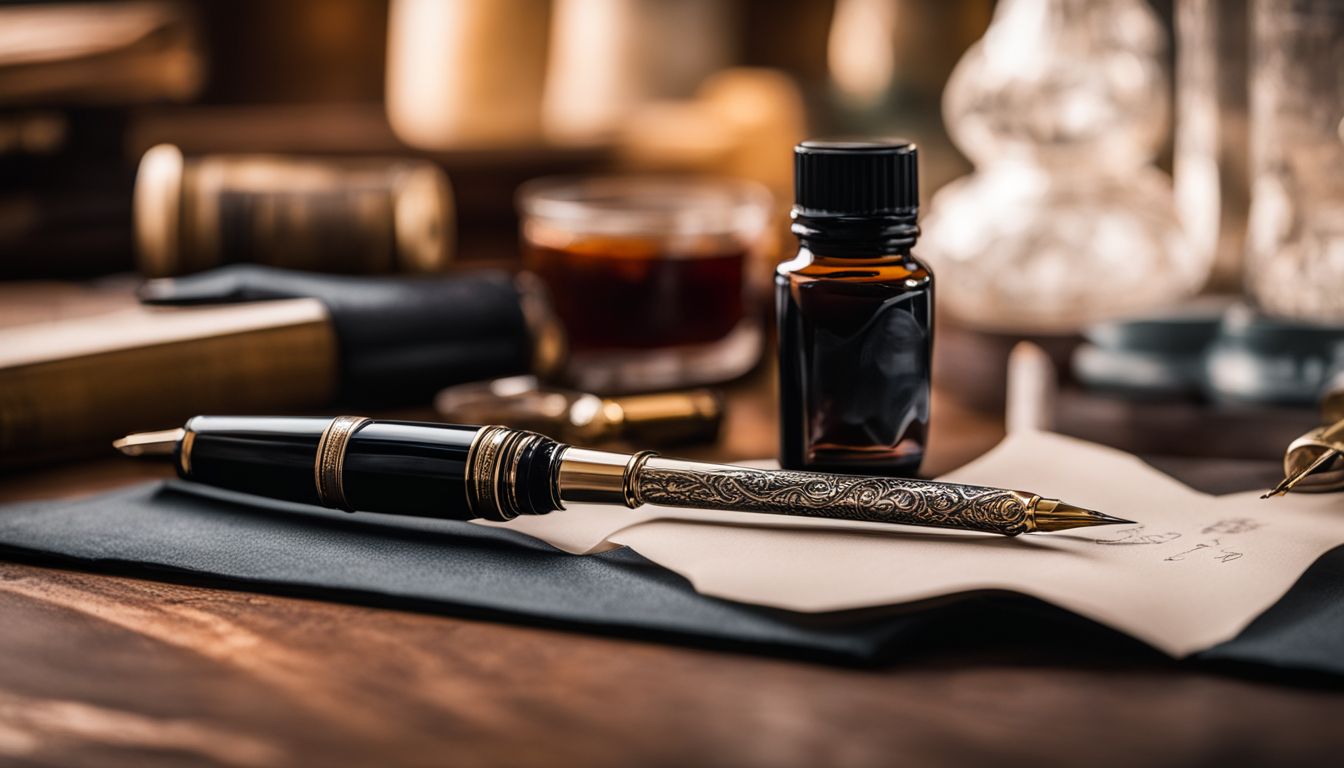Is your cherished fountain pen suddenly scratching across the page, more silent than flowing? You’re not alone—dry fountain pens can sneak up on any writing enthusiast. Our guide is packed with six straightforward solutions to breathe life back into your pen, ensuring a smooth and uninterrupted flow of ideas onto paper once again.
Let’s get that ink moving!
Key Takeaways
- If your fountain pen is dry, rinse the nib under warm water or use a bulb syringe to flush out old ink.
- A clogged nib can be cleaned by soaking it in a solution, and applying gentle pressure to the cartridge might help ink flow better.
- Try using wetter inks like Sailor Jentle Inks or different paper designed for fountain pens if you still have trouble.
- Adjusting the pen’s nib can improve ink flow – consider bending the tines carefully or switching to a finer Japanese nib for more control.
- Prevent leaks and drying by cleaning your pen regularly, storing it upright, and using fresh, quality ink.
Identifying the Problem with Your Dry Fountain Pen

Check your pen nibs and ink cartridge if your fountain pen isn’t writing properly. A clogged feed could be the culprit, blocking smooth ink flow. Dirt, dried ink or debris can cause these blockages.
Look closely to see if the nib is damaged or bent. This can also disrupt how well your fountain pen works.
A dry fountain pen often means the ink has evaporated from disuse or poor storage conditions. Sometimes an incompatible ink type leads to poor performance, especially in European pens known for finer lines.
Think about when you last used your pen—long periods without writing can lead to drying out.
Six Easy Solutions to Revive Your Dry Fountain Pen

If you’ve discovered that your prized fountain pen has succumbed to dryness, fret not—revival is within reach. With a handful of straightforward strategies, you can reawaken the flow of ink and restore your writing instrument’s former glory without a trip to the repair shop.
Flushing the Pen with Warm Water
Take apart your fountain pen and hold the nib under warm running water. This helps loosen any dried ink inside. If your fountain pen has a cartridge converter, remove it before starting this process.
Use a bulb syringe to flush out the feed if just water doesn’t do the trick. Fill the syringe with warm water and attach it to where the cartridge or converter goes. Gently squeeze to flush until clear water comes out.
This method cleans deeper than simple rinsing does, ensuring that all remnants of old ink are washed away from your Platinum Preppy or any other type of fountain pen you own. After flushing, dry each part with a soft cloth before reassembling your pen and filling it with fresh fountain pen ink from Amazon.com or another trusted source.
Cleaning the Nib
Dirt and dried ink can block your fountain pen’s nib, stopping the ink flow. A clogged nib needs a good clean to get it working again. Rinse the nib under warm water to loosen any dried ink.
Then fill and empty it with water using a bulb syringe until the water runs clear.
For deeper cleaning, soak the nib unit in a solution like Pen Chalet Pen Flush for a few minutes. This helps dissolve stubborn ink clogs and primes the nib for better writing. After soaking, rinse with warm water again before reassembling your pen.
Now that you’ve cleaned the nib, if issues persist, consider applying gentle pressure to the cartridge next for an improved ink flow.
Applying Pressure to the Cartridge
After you’ve cleaned the nib, another trick to get your fountain pen working is applying pressure to the cartridge. Gently squeeze the sides of the ink cartridge—it can push ink into the feed and moisten a dry nib.
If your pen has a converter, try twisting it slightly. This action also primes the nib by moving ink towards it. These steps often fix problems with ink evaporation or clogged feeds.
They are simple to do and might be just what your pen needs to start writing smoothly again.
If these methods don’t work, don’t worry! You have other options like changing inks or adjusting the paper you use. Keep experimenting until you find what revives your cherished fountain pen.
Switching to a Wetter Ink
If applying pressure doesn’t get the ink flowing, consider changing your ink. A dryer ink may cause problems and stop the pen from writing smoothly. Wetter inks are often better for pens that tend to dry out.
These inks can keep things moving and prevent clogs.
Look for self-lubricating options like Sailor Jentle Inks, known to enhance writing experience. With these smoother-flowing inks, your fountain pen’s feed system works more efficiently.
This simple switch could be what your pen needs to start creating beautiful lines again without interruption.
Trying a Different Paper Type
After choosing wetter ink, consider the paper you’re using. Some papers make it hard for fountain pens to work well. They may not absorb ink properly or allow the pen to glide smoothly.
Try using a higher quality paper that is smoother and designed for fountain pens. This type of paper helps your pen write better and stops the ink from drying up quickly on the nib.
A good choice might be a heavy, cotton-based paper or one with a slight coating meant for fountain pen use. This can change how your writing feels and looks dramatically. The right paper absorbs ink just enough without making it spread too much or bleed through.
You’ll notice your writing looks sharper and your pen stays primed longer, ready when you are to write again!
Making Nib Alterations
Switching paper types can improve ink flow, but sometimes the nib itself may need attention. Have you noticed your fountain pen scratching or skipping? It could be time to adjust the nib.
Carefully bend the tines of your fountain pen’s nib to increase or decrease flow. This is called priming the nib. Be gentle; you don’t want to overdo it and damage the nib.
European pens often come with wider nibs that lay down more ink. If these aren’t giving you a good line, try a Japanese pen with a finer nib for less ink use and better control. Each adjustment makes a difference in how your pen writes.
Keep practicing until you get that perfect flow! Remember, little changes can lead to significant improvements without buying a new pen.
Preventive Measures to Stop Your Fountain Pen from Leaking
Taking care of your fountain pen is important. Proper maintenance prevents leaks and keeps your writing smooth. Here are some tips to help:
- Clean your pen regularly. Use Pen Chalet Pen Flush or just warm water every few weeks.
- Store your pen properly. Keep it upright when not in use to prevent ink from settling in the wrong places.
- Use fresh ink. Stale or old ink can clog and cause leaks.
- Check the nib and feed alignment. They should fit snugly together without gaps.
- Tighten all parts securely. Make sure the barrel, cap, and nib section are not loose.
- Choose quality ink that matches your pen’s requirements. Self – lubricating inks like Sailor Jentle Inks are good choices for smooth flow without leaks.
- Handle with care. Avoid dropping or jostling the pen to protect its delicate parts from damage.
Conclusion
If your fountain pen dries up, don’t worry. You have six simple fixes to get it flowing smoothly again. Try cleaning with warm water or switching the ink. If that doesn’t work, look at the paper you’re using or adjust the nib.
Remember, keeping your pen clean and using it regularly can prevent drying in the first place. Keep writing and enjoy the smooth glide of a well-maintained fountain pen!
To learn more about preventing leaks and keeping your writing experience flawless, check out our guide on how to stop your fountain pen from leaking.
FAQs
1. What’s the first thing I should do if my fountain pen dries up?
Try dipping your pen’s nib in warm water for a few minutes to get the ink flowing again.
2. Can I use any kind of ink to refill a dried-up fountain pen?
Stick with using the same brand of ink or one that’s specifically compatible with your fountain pen.
3. What if cleaning my fountain pen doesn’t fix the dryness?
If cleaning doesn’t work, gently squeeze or prime the cartridge or converter to encourage ink flow.
4. Are there any quick fixes for a dried-up fountain pen when I’m on the go?
Yes, you can moisten the nib with saliva as a temporary solution until you’re able to clean it properly.
5. Should I store my fountain pen in a special way to prevent it from drying out?
Keep your fountain pen capped and store it with the nib facing upwards when not in use.




Leave a Reply
You must be logged in to post a comment.